Headlines and events archive
Displaying 351 - 400 of 1543
You may also find an archive of news published in the media which are related with the Instituto de Astrofísica de Andalucía - CSIC.
Pages

|
23/07/2020 - 12:30
X-ray Astronomy for non (X-ray) astronomers Observations of X-rays coming from outside the solar system were pioneered in 1962 by Riccardo Giacconi and colleagues. From that very day, it became evident that X-rays would reveal a very different Universe to that shown by optical or radio telescopes. Indeed, X-rays are typically produced in the environment of black holes, or where the ambient temperature exceeds millions of degrees. X-ray telescopes (which, for good reason, are in orbit)... Dr. Xavier Barcons |

|
25/06/2020 - 12:30
Peering into the Dark: Probing the Formation and Early Evolution of Massive Stars This presentation will focus on recent work aimed at understanding the formation and early evolution of massive protostars. The massive (M>8 Msol) stars into which these evolve are the primary drivers of galactic ecosystems. The energy and nuclear processed material these massive stars inject into their enviroment during their lives and ultimately as supernovae, shapes the physical and chemical evolution of the ISM in galaxies. These stars... Dr. Gary Fuller |

|
14/05/2020 - 12:30
Gamma-ray Emitting Narrow Line Seyfert 1 Galaxies: Past, Present, & Future The detection of significant gamma-ray emission from about a-dozen radio-loud narrow line Seyfert 1 (NLSy1) galaxies by Fermi-Large Area Telescope has opened up a realm to explore the physical conditions needed to launch relativistic jets in a different central engine and host galaxy environment than that is known for more-common jetted active galactic nuclei, i.e. blazars. Promising results acquired from various multi-wavelength campaigns are... Dr. Vaidehi S. Paliya |

|
10/09/2020 - 12:30
SO Web-loquio: Massive black hole binaries in the cosmos Massive black holes weighing from a few thousands to tens of billions of solar masses inhabit the centers of today's galaxies, including our own Milky Way. Massive black holes also shone as quasars in the past, with the earliest detected a mere one billion years after the Big Bang. Along cosmic time, encounters between galaxies hosting massive black holes in their centers have produced binary massive black holes that eventually coalesced by... Dr. Marta Volonteri |

|
18/02/2020 - 12:30
Evolution of statistical techniques in Astronomy The requirement for more robust statistical tools is becoming increasingly higher owing to the demands of various large programmes and the technological advancement producing high-sensitive observations across the electromagnetic spectrum. Among the many existing analyses, the ones working on the time-series as set by the monitoring projects using single-dish/optical telescopes and those of spectral-line observations as rendered by ALMA/IFUs are... Dr. Venkatessh Ramakrishnan |

|
04/06/2020 - 12:30
TuMaG: un magnetógrafo para Sunrise III After the scientific success of the two first flights of the Sunrise stratospheric balloon mission, the international consortium led by MPS (Göttingen, Germany) decided to re-issue the mission for a third time. For Sunrise III, a new gondola and navigation system will be provided by APL (Johns Hopkins University, MD) and the re-furbished telescope by MPS. The latter also provides the instrumental platform and the light distribution system while... Dr. José Carlos del Toro Iniesta |
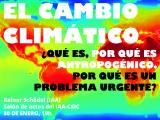
|
30/01/2020 - 19:00
What is climate change, why is it anthropogenic and why is it an urgent problem? What is climate change, why is it anthropogenic and why is it an urgent problem? Rainer Schödel |
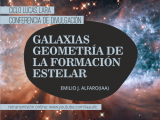
|
19/12/2019 - 19:00
Galaxies. Geometry of star formation Outreach conference Emilio J. Alfaro |

|
28/11/2019 - 19:00
If we cannot save Galapagos, what can we save? Outreach conference Silbia López de Lacalle |

|
18/06/2020 - 12:30
Exploring the origin of gas-rich ultra-diffuse galaxies with HI kinematics Ultra-diffuse galaxies (UDGs) are one of the most discussed topics in extra-Galactic astronomy in the last lustrum given their puzzling properties: they have luminosities typical of dwarf galaxies, but optical scale lengths similar to very massive spirals. This intriguing combination is hard to explain, and up to date the precise formation mechanism of UDGs remains unknown. With the goal of learning more about their origins, our group has... Pavel E. Mancera Piña |

|
20/02/2020 - 12:30
YOUNG RUNAWAY STARS Most stars have spatial velocities within a few km/s of the average velocity of their surroundings and can be considered to be gravitationally trapped. There are, however, a small number of stars that move at velocities of tens or even hundreds of km/s with respect to their environment and that will eventually escape from there. The archetypal runaway stars are mu Col and AE Aur that escaped in opposite directions from the vicinity of the Orion... Dr. Luis Felipe Rodriguez |

|
11/02/2020 - 12:30
Experiments with MUSE data: Finding SN remnants & other curious sources One of the ways of following up on the success story of CALIFA is to refine the spatial resolution, and MUSE is the tool for that. Its superb image quality allows for a different kind of science. While browsing through emission line images derived from MUSE datacubes, we have spotted a number of compact-looking sources with forbidden line emission ([OIII], [NII], [SII]) in excess of that typical of HII regions. NGC 4030, a late type spiral 30... Dr. Roberto Cid Fernandes |

|
04/02/2020 - 12:30
Cosmic butterflies: the product of tempestuous stellar marriages Planetary nebulae are some of the most strikingly beautiful astrophysical phenomena known, gracing many a glossy-paged, coffee-table book and earning them the nickname "cosmic butterflies". Classical stellar evolutionary theory states that all intermediate mass stars should produce a planetary nebula, forming as the star leaves the Asymptotic Giant Branch and evolves towards the white dwarf phase. While it remains the standard for astronomy... Dr. David Jones |

|
30/07/2020 - 12:30
SO Webloquio:The Orion Radio All-Stars: new insights into YSO radio emission, using the VLA, VLBA, and ALMA With significant new observing capabilities, centimeter-wavelength radio astronomy is currently in a renaissance leading up to the advent of the Square Kilometre Array (SKA), highlighting new opportunities and also technical challenges. The sensitivity upgrades of both the NRAO Very Large Array (VLA) and the Very Long Baseline Array (VLBA) have begun to provide us with a much improved perspective on stellar centimeter radio emission,... Jan Forbrich |

|
19/03/2020 - 12:30
Study on astrophysical masers in the era of SKA/SKA-VLBI In my colloquium talk, out of the introduction topics mentioned above, I will focus my talk on trigonometry of maser sources yielded with the Square Kilometre Array (SKA) Phase 1. This is one of the science cases that have been planned as Japanese scientific contributions to SKA1. Its key issue is the scientific and technical feasibility in the low frequency band, corresponding to SKA1-MID Band 2 around 1.6 GHz, in which atmospheric effects on... Dr. Prof Hiroshi Imai |

|
31/01/2020 - 12:30
NoiseChisel and Gnuastro: non-parametric detection and analysis of astronomical targets Astronomical instrumentation has greatly advanced over the last 40 years: with digital detectors, space telescopes and +8m class ground-based telescopes for example. However, the signal-based detection paradigm (for example from Petrosian or Kron in the 1970s, mostly used as implemented in SExtractor from the mid-1990s) is still the dominant method of low-level data analysis: detection, segmentation and measurements or catalog production. In... Dr. Mohammad Akhlagh |

|
09/01/2020 - 12:30
Galaxy evolution and weak lensing studies in the J-PAS survey During the next year, the J-PAS survey will start imaging the northern sky with a unique photometric system composed of 56 narrow and 4 broad bands. The peculiar configuration and strategy of this survey pursue to provide accurate low-resolution spectra or photo-spectra (FWHM~125 \AA) allowing us to obtain high-quality photometric redshifts (\sigma_z~0.003 for LRGs) for millions of galaxies across 8000 deg^2 of the sky. Recently, the J-PAS... Dr. Luis Díaz García |

|
27/02/2020 - 12:30
Proper motion study of the Galactic Centre Stellar proper motion studies in the centre of the Milky Way have been typically limited to the Quintuplet, Arches, and central parsec clusters. In this talk, I will present the primary results of a large-scale proper motion study of the central ~ 36' x16' of the Galaxy based on our GALACTICNUCLEUS survey (epoch 2015) combined with the HST Paschen-alpha survey (epoch 2008). This region of our Galaxy is not covered sufficiently by the existing... Dr. Banafsheh Shahzamanian |

|
19/12/2019 - 12:30
The SKA precursor telecope MeerKAT as a galaxy evolution explorer MeerKAT is a radio telescope situated in South Africa's Karoo desert. It has recently been built as an SKA demonstrator and precursor telescope and was inaugurated in August 2018. Since then it has proven to be the world's most sensitive 20cm interferometer and is slowly moving towards standard operation. Thanks to its array layout MeerKAT is a superb telescope to observe in particular the HI line, hence tracing the most abundant atom in its... Dr. Józsa Gyula István Géza |

|
05/03/2020 - 12:30
Round Table: Dia de la Mujer To be provided Round Table |

|
30/01/2020 - 12:30
Mirror-slicer Array for Astronomical Transients. A new Integral Field Spectroscopy mode for OSIRIS at GTC MAAT (Mirror-slicer Array for Astronomical Transients) is proposed as a new mirror-slicer optical system that will allow the OSIRIS spectrograph at the 10.4 m GTC the capability to perform integral-field spectroscopy (IFS) over a seeing-limited field of view 14.20’' x 10'' with a slice width of 0.303''. MAAT will enhance the resolution power of OSIRIS by 1.6 times with respect to its 0.6'' wide long-slit. All the eleven OSIRIS grisms and VPHs... Dr. Francisco Prada |

|
05/12/2019 - 12:30
Gaia mapping mission and science of Solar System Objects I will present the generalities of the Gaia surveying mission, and current status. I will then discuss the improvement brought by Gaia over its 5 years and more of mission—starting with DR1—for the science of asteroids and other SSOs; and focusing especially on the astrometry and dynamics of asteroids. After reminding generalities on SSO observations by Gaia - and some of their peculiarities, we present some of the advances obtained from the... Dr. Daniel Hestroffer |

|
10/12/2019 - 12:30
SO-IAA Colloquium: Unveiling the nature of planetary systems The burgeoning field of exoplanets has yielded thousands of discoveries, which collectively have the potential to help us better understand our place in the Universe. Every month more and more planetary systems are being discovered,some of them in highly exotic configurations never observed previously. The combination of different techniques and studies are needed to unveil the real nature of these planetary systems. In this seminar, I will... Dr. Francisco Pozuelos |
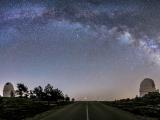
|
20/11/2019
Public Surveys and new instrumentation for Calar Alto Observatory Calar Alto Observatory opens a call for new instrumentation projects |

|
13/02/2020 - 12:30
From protostars to planets: the astrochemical link Protostars accrete their material from the natal cloud through accretion disks. These disks are progressively dispersed by the recently formed star to form protoplanetary discs in which planets are born. Although this process takes a few million years, now we think that the final chemical composition of the gas and dust in the proto-planetary disk is to a large extent determined by the chemical evolution in the natal cloud. Determining the... Dr. Asunción Fuente |

|
26/11/2019 - 12:30
Inverse Compton emission revealed by observations up to TeV energies of GRB 190114C The hunt for Gamma-Ray-Bursts (GRBs) at very high energy (VHE) started more than 20 years ago. A hint of emission was already claimed by Milagrito from the observations of GRB 970417. On 19 of January the Major Atmospheric Gamma Imaging Cherenkov (MAGIC) clearly detected GRB 190114C above 0.2 TeV. This is the first highly significant detection (over 50sigma reached in the first few tens of minutes after the burst) of a GRB at VHE. GRB190114C... Dr. Elena Moretti |

|
23/01/2020 - 12:30
SO Colloquia: Extragalactic survey science in the 2020s: the role of radio continuum observations with the SKA Extragalactic surveys in the 2020s will reveal the full diversity of the galaxy assembly process: from environment-dependent evolution to the build-up of mass inside galaxies, and with a complete accounting of all relevant processes/constituents ensured by multi-wavelength coverage. Observations at radio wavelengths carry a unique potential in that they can probe star-formation activity and cold gas content, i.e. place constraints on both galaxy... Mark T. Sargent |

|
15/01/2020 - 12:30
Public Surveys and new instrumentation for Calar Alto Observatory The Calar Alto observatory (CAHA) is a key institution for the international astronomical community, for its highly competitive astronomical facilities (telescopes and instrumentation). From 2019 on, the current administration of CAHA includes the Junta de Andalucía as a new partner – replacing the Max Planck Gesellschaft -, and together with the Spanish National Research Council (CSIC) these two institutions manage the operation of the... Dr. Jesus Aceituno |

|
31/10/2019 - 00:15
Seriously: Is anyone out there? Juan Carlos Suárez |

|
06/02/2020 - 12:30
SO Colloquia: Extrasolar planets: recent advances and future challenges Recently a group of scientists has confirmed the presence of water in the atmosphere of a super Earth orbiting in the habitable zone of its host star. But what what does this milestone represent in the search for life outside Earth? What do we mean by habitable? What do we really know about extrasolar planets, their internal structure or origins? What is a super Earth, the most common planet category know to date for which no example is found in... Dr. Juan Cabrera |

|
29/10/2019 - 12:30
Nebular HeII emission from spatially resolved metal-poor star-forming galaxies Nebular HeII1640,4686 emission, observed to be more frequent in high-z galaxies than locally, is indicative of far harder ionizing spectrum than that seen in nearby systems. Star-forming galaxies with lower metal content tend to have a larger nebular HeII intensities compared to those with higher metallicities. This agrees with the expected harder spectral energy distribution at the lower metallicities typical in the early universe. Theoretical... Dra. Carolina Kehrig |

|
04/10/2019 - 12:30
Cúmulos Jóvenes: eclosionando, moviéndose, volando En las últimas dos décadas, nuestro conocimiento de los cúmulos estelares jóvenes, ha progresado rápidamente del uso de imágenes estáticas con cada vez mayor calidad, hacia mapas de movimientos en seis dimensiones (posiciones, velocidades), que están cambiando muchas de nuestras ideas de cómo los cúmulos estelares surgen de los complejos de nubes moleculares. Conforme nos movemos de escalas de parsecs a hectoparsecs, ahora vemos a los cúmulos... Dr. Carlos G. Román Zúñiga |

|
22/10/2019 - 12:30
Data mining Gaia DR2: the quest for Pre-Main Sequence Stars (and their discs) As the birth-sites of planets, protoplanetary discs have become the object of intense study during the last years. Constraining their typical lifetimes, masses and/or sizes is crucial to understand the process of planet formation. These objects are a natural by-product of early stellar evolution, and therefore a high fraction of Pre-Main Sequence Stars (PMS) are surrounded by a protoplanetary disc. The current census of PMS (and discs) has been... Dr. Héctor Cánovas |

|
02/12/2019 - 12:30
Molecular outflows: evolution, structure and angular momentum We present a theoretical model in order to explain the formation and the evolution of the molecular outflows associated to protostars. In this model, we assume that the molecular outflow is a thin shell formed by the interaction between a fast stellar wind and a rotating cloud envelope in gravitational collapse. We obtain a set of partial differential equations, these equations are space and time dependent, and describe the physical properties... Dr. Alejandro López Vázquez |

|
23/10/2019 - 12:30
Molecular spectroscopy at high resolution for everyone Molecular observations at high resolution is being revolutionized by the success of ALMA and the upcoming advent of SKA. In this talk I will explain the recent progress in the field of molecular observations in the central regions of galaxies and the big steps that we are currently making in the use and understanding of molecular tracers as a proxy to buried physical processes in active galaxies. I will show some preliminary results from the... Dr. Sergio Martín Ruiz |

|
19/09/2019 - 12:30
JPAS: A survey for Galaxy Evolution studies JPAS is a survey of 5000-8000 deg2 of the sky with 56 narrow band filters in the Observatory of Javalabre. This survey is very relevant for Cosmology, Galaxy Evolution and Stellar Physics studies. In January 2020, JPAS with its JPCam will have the first light. However, the project has already taken data of 2 deg2 of the sky in two cosmological fields (AEGIS and JWST-NEP). The 2-4th of December will be the first data release (DR1) during the RIA... Dr. Rosa González Delgado |

|
28/11/2019 - 12:30
SO-IAA Colloquium: Recent advances about the exoplanetary exospheres The upper atmosphere of a planet plays a key role at protecting the lower altitudes from the effects of energetic stellar EUV and soft X-ray photons and keV-energy precipitating particles. Through a variety of transport processes, the upper atmosphere also participates in the net loss of a planet’s bulk composition into space. As such, the physics and chemistry occurring in the upper atmosphere influence the evolution of a planet over its... Antonio García Muñoz |

|
07/11/2019 - 12:30
SO-IAA Colloquium: Characterization of (exo)Planetary Atmospheres Characterization of planetary atmospheres has always been a challenge. While the next generation of facilities, such as ELT, JWST, and ARIEL, will improve our understanding of planetary atmospheres, the number of well-characterized exoplanet atmospheres is expected to remain limited. Large-scale simulations assist us with this shortcoming by predicting the diversity of the planetary atmospheres, connecting the spare observational measurements,... Dr. Karan Molaverdikhani |

|
03/10/2019 - 12:30
Some aspects of high precision machines for astronomical applications Cranfield Precision are not specialists in astronomy but their expertise in designing and building very precise special-purpose machines has contributed to several important astronomical projects. In this talk I will show several machines with astronomical applications and select some features of particular interest for discussion. Richard May-Miller |

|
05/09/2019 - 12:30
Broad line AGN in the MaNGA survey This talk presents a way to find Type I Active Galactic Nuclei in the MaNGA survey (Mapping Nerby Galaxies at Apache point observatory). The method is based on flux ratios between spectral regions where a broad line in emission is expected. Likewise, the spectroscopic analysis of 44 galaxies with nuclear activity is shown; as well as the estimation of the mass of supermassive black holes and the effect that the active nucleus has on... Dra. Alenka Negrete |

|
17/10/2019 - 12:30
SO-IAA Colloquium: What's is the metallicity of cool dwarf stars? Cool dwarfs are the most numerous stars in the Galaxy and they account for most of its baryonic mass. However, they are likely the least understood main sequence stars. Their complex atmospheres, due to their low temperatures and high surface gravities, have made their spectroscopic study a hard task. Until recently, their basic physical properties, such as radii and mass, were poorly constrained due to the lack of empirical data. Stellar... Bárbara Rojas-Ayala |

|
12/09/2019 - 12:30
Detection of Exocomets: The gaseous environment of Main-Sequence Stars Planetesimals and small solid bodies in general are key to understand the chemical and dynamical evolution of planetary systems. Direct detection outside the Solar System is still not feasible. However, indirect evidences of such bodies as dusty debris disks or the presence of large amounts of gas in the close-in surroundings of main-sequence stars have been collected for over 30 years now. Transient events observed as variable non-... Dr. Isabel Rebollido |

|
10/10/2019 - 12:30
THE INNER DEBRIS OF SN1987A: MOLECULAR AND DUST EMISSION The supernova SN1987A in the Large Magellanic Cloud, together with new instrumentation like ALMA, offers an unprecedented opportunity to tackle fundamental issues of supernova explosions. Large masses of molecules and dust have been formed in its inner debris over the last 25 years. Recently developed tomographic techniques have allowed to obtain 3D-images of its molecular emission. Also, high-resolution images of dust emission have recently... Prof. Jon Marcaide |

|
12/12/2019 - 12:30
NGC 7469 as seen by MEGARA: new results from high-resolution IFU spectroscopy In this talk I will present highlights from our recent work about the analysis of high-resolution (R ~ 20 000) GTC/MEGARA integral-field unit spectroscopic observations, obtained during the commissioning run, in the inner region (12.5arcsec×11.3arcsec) of the active galaxy NGC7469, at spatial scales of 0.62 arcsec. We explore the kinematics, dynamics, ionisation mechanisms and oxygen abundances of the ionised gas, by modelling the Hα-[NII]... Dr. Sara Cazzoli |

|
24/10/2019 - 12:30
ANALOGUES OF HIGH REDSHIFT GALAXIES: DISENTANGLING THE COMPLEXITY OF THE GREEN PEAS Young low-mass galaxies with extreme emission-line properties are ubiquitous at high redshift and they are believed to play a key role in cosmic reionisation and the early growth of galaxies at z>4-6. However, a detailed characterisation of their physical properties, critical for a better understanding of these two outstanding problems, is yet not possible. A unique population of lower-z analogues of these primeval systems, dubbed Green Pea (GP... Dr. Ricardo Amorin |

|
14/11/2019 - 12:30
SO-IAA Colloquium: Outflows and their feedback effect in galaxies Galactic outflows are an essential component of galaxies' lifecycle. They regulate star formation and can even totally quench star formation in galaxies, hence transforming star forming galaxies into passive systems. I will review the properties of galactic outflows, their multi-phase nature, their driving mechanism, both in normal star forming galaxies and in galaxies hosting Active Galactic Nuclei, both in the local Universe and in... Dr. Roberto Maiolino |

|
12/11/2019 - 12:30
Study of the diversity of AGN dust models The dust component of active galactic nuclei (AGN) produces a broad infrared spectral energy distribution (SED), whose power and shape depends on the fraction of the source absorbed, and the geometry of the absorber respectively. This emitting region is expected to be concentrated within the inner ∼5 pc of the AGN which makes almost impossible to image it with the current instruments. The study the infrared SED by comparison between infrared AGN... Dr. Omaira González-Martín |
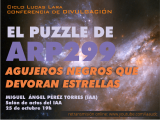
|
25/10/2018 - 19:00
The Arp299 puzzle. Black holes that devour stars In January 2005, a bright flash was detected in the nucleus of the galaxy in the process of fusion Arp 299-B, which was considered a supernova explosion. However, ten years of observations at different wavelengths have allowed us to witness how the luminous region was lengthening and expanding, and to conclude that it is a jet of material expelled by the galaxy's central super-massive black hole after tearing a star. Miguel Ángel Pérez-Torres |
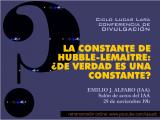
|
29/11/2018 - 19:00
The Hubble-Lemaître constant: is it really a constant? Following an open debate, the International Astronomical Union recently recommended that the rate of expansion of the universe, traditionally referred to as the "Hubble Constant", should henceforth be referred to as the "Hubble-Lemaître Constant". Emilio J. Alfaro |
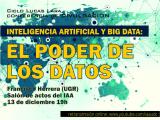
|
13/12/2018 - 19:00
Artificial Intelligence and big data: the power of data Artificial Intelligence and big data: the power of data. Outreach conference Francisco Herrera |